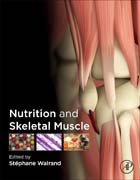
Nutrition and Skeletal Muscle provides complete coverage of the evidence of dietary components that are proven beneficial for bettering adverse changes in skeletal muscle from disuse and aging. Skeletal muscle is the largest tissue in the body providing the elements of contraction and locomotion as well as acting as an important contributor to whole body protein and amino metabolism, glucose disposal and lipid metabolism. However, muscle loss and atrophy or weakness can occur when there are metabolic imbalances, disuse or aging. Research has shown some dietary components as beneficial for ameliorating adverse changes in skeletal muscle and improving muscle strength and performance. These compounds range from amino acids to a variety of nutraceuticals. They can affect skeletal muscle directly or whole body metabolism via their actions on skeletal muscle. While these advances have been identified, they have yet to be marshalled into a single comprehensive scientific text. Nutrition and Skeletal Muscle addresses this need in a comprehensive way by providing insight and research from international leaders in the field, making it the go-to reference for anyone involved in the study of skeletal muscle physiology. Provides an understanding behind the crucial role of skeletal muscle in global metabolic homeostasis regulationDelivers the information needed to understand the utilization of crucial supplements for the preservation of skeletal muscleProvides insights on research from international leaders in the field in one reference INDICE: Part 1. General Aspects 1. Physiological regulation of muscle mass 2. Skeletal muscle mass indices in healthy adults 3. Myofibrillar proteins 4. Reduced skeletal muscle mass and lifestyle 5. Postprandial effects on skeletal muscle 6. Molecular mechanism of post-meal regulation of muscle anabolism 7. Age-related changes in skeletal muscle Part 2. High fat and overfeeding 8. Skeletal muscle mitochondrial and high fat feeding 9. Muscle macrophages and high fat feeding 10. Muscle insulin action and high fat feeding 11. Oxidative stress in skeletal muscle and high fat feeding 12. Maternal overnutrition and skeletal muscle in offspring Part 3 Obesity 13. Sarcopenic obesity 14. Skeletal muscle and chronic overfeeding 15. Lipolysis in skeletal muscle of obesity 16. Obesity and respiratory skeletal muscles Part 4. Diabetes, insulin and glucose control 17. Correlates of skeletal muscle strength in diabetes 18. Lipids in skeletal muscle and insulin sensitivity 19. Glucose, skeletal muscle and obesity Part 5 Vitamins 20. Vitamin D signaling and skeletal muscle cells 21. Vitamin D deficiency and myopathy 22. Vitamin D and age-related loss of muscle mass and function 23. Vitamin D and exercise in humans 24. Vitamin D and skeletal muscle of amyotrophic lateral sclerosis 25. Vitamin E and skeletal muscle 26. Folate and skeletal muscle 27. Thiamine and skeletal muscle Part 6 Minerals 28. Copper and skeletal muscle 29. Iron and skeletal muscle 30. Selenium and skeletal muscle 31. Zinc and skeletal muscle 32. Calcium and skeletal muscle Part 7 Nutraceuticals and supplements 33. Coffee, Caffeine and skeletal muscle 34. Daidzein and skeletal muscle protection 35. Epigallocatechin-3-gallate and skeletal muscle recovery 36. Genistein and skeletal muscle 37. Grape seed proanthocyanidin and skeletal muscle protection 38. Soy beta-conglycinin and skeletal muscle 39. Quercetin and skeletal muscle fat 40. Resveratrol and skeletal muscle protection 41. Pre- and probiotics, microbiota and skeletal muscle Part 8 Amino acid supplements 42. Arginine and skeletal muscle 43. Citrulline and skeletal muscle 44. Sulfur amino acids and skeletal muscle 45. Branched-chain amino acids (leucine, isoleucine, and valine) and skeletal muscle 46. Glutamine and skeletal muscle 47. Tryptophan and skeletal muscle Part 9 Protein supplements 48. Mixture of whey protein and casein on skeletal muscle 49. Whey protein and muscle protection 50. Casein-enriched diets and muscle 51. Dietary protein and skeletal muscle in elderly 52. Mechanisms of muscle anabolic resistance 53. Dietary amino acids and protein hydrolysates compared with intact proteins and skeletal muscle 54. Dietary plant proteins and skeletal muscle 55. Protein supplement, exercise and skeletal muscle Part 10 Lipid supplements 56. Dietary fat and skeletal muscle: molecular apects 57. Polyunsaturated omega-3 fatty acids and skeletal muscle 58. Fatty acids and skeletal muscle PPAR 59. Saturated and monounsaturated fatty acids and skeletal muscle Part 11 Adverse effects due to dietary components, deficiencies, modulants or extracts 60. Statins and muscle damage 61. Protein restriction and impact on skeletal muscle 62. Nutritionnelles 63. Caloric restriction and impact on skeletal muscle 64. Seafood contaminants (palytoxins) on skeletal muscle 65. Alcoholic myopathy
- ISBN: 978-0-12-810422-4
- Editorial: Academic Press
- Encuadernacion: Cartoné
- Páginas: 576
- Fecha Publicación: 01/11/2018
- Nº Volúmenes: 1
- Idioma: Inglés
